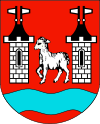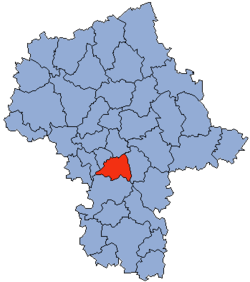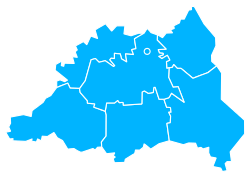Piaseczno County
Piaseczno County (Polish: powiat piaseczyński) is a unit of territorial administration and local government (powiat) in Masovian Voivodeship, east-central Poland. It came into being on January 1, 1999, as a result of the Polish local government reforms passed in 1998. Its administrative seat and largest town is Piaseczno, which lies 17 kilometres (11 mi) south of Warsaw. The county contains three other towns: Konstancin-Jeziorna, 8 km (5 mi) east of Piaseczno, Góra Kalwaria, 18 km (11 mi) south-east of Piaseczno, and Tarczyn, 16 km (10 mi) south-west of Piaseczno.
Piaseczno County Powiat piaseczyński | |
|---|---|
 Flag  Coat of arms | |
 Location within the voivodeship | |
 Division into gminas | |
| Coordinates (Piaseczno): 52°4′0″N 21°1′0″E | |
| Country | |
| Voivodeship | Masovian |
| Seat | Piaseczno |
| Gminas | |
| Area | |
| • Total | 621.04 km2 (239.78 sq mi) |
| Population (2006) | |
| • Total | 145,276 |
| • Density | 230/km2 (610/sq mi) |
| • Urban | 69,103 |
| • Rural | 76,173 |
| Car plates | WPI |
| Website | http://www.piaseczno.pl |
The county covers an area of 621.04 square kilometres (239.8 sq mi). As of 2006 its total population is 145,276, out of which the population of Piaseczno is 37,508, that of Konstancin-Jeziorna is 16,579, that of Góra Kalwaria is 11,130, that of Tarczyn is 3,886, and the rural population is 76,173.
Neighbouring counties
Piaseczno County is bordered by the city of Warsaw to the north, Otwock County to the east, Grójec County to the south, Grodzisk Mazowiecki County to the west and Pruszków County to the north-west.
Administrative division
The county is subdivided into six gminas (four urban-rural and two rural). These are listed in the following table, in descending order of population.
| Gmina | Type | Area (km²) |
Population (2006) |
Seat |
| Gmina Piaseczno | urban-rural | 128.2 | 62,823 | Piaseczno |
| Gmina Góra Kalwaria | urban-rural | 145.1 | 24,035 | Góra Kalwaria |
| Gmina Konstancin-Jeziorna | urban-rural | 78.3 | 23,229 | Konstancin-Jeziorna |
| Gmina Lesznowola | rural | 69.2 | 16,113 | Lesznowola |
| Gmina Tarczyn | urban-rural | 114.2 | 10,522 | Tarczyn |
| Gmina Prażmów | rural | 86.1 | 8,554 | Prażmów |
